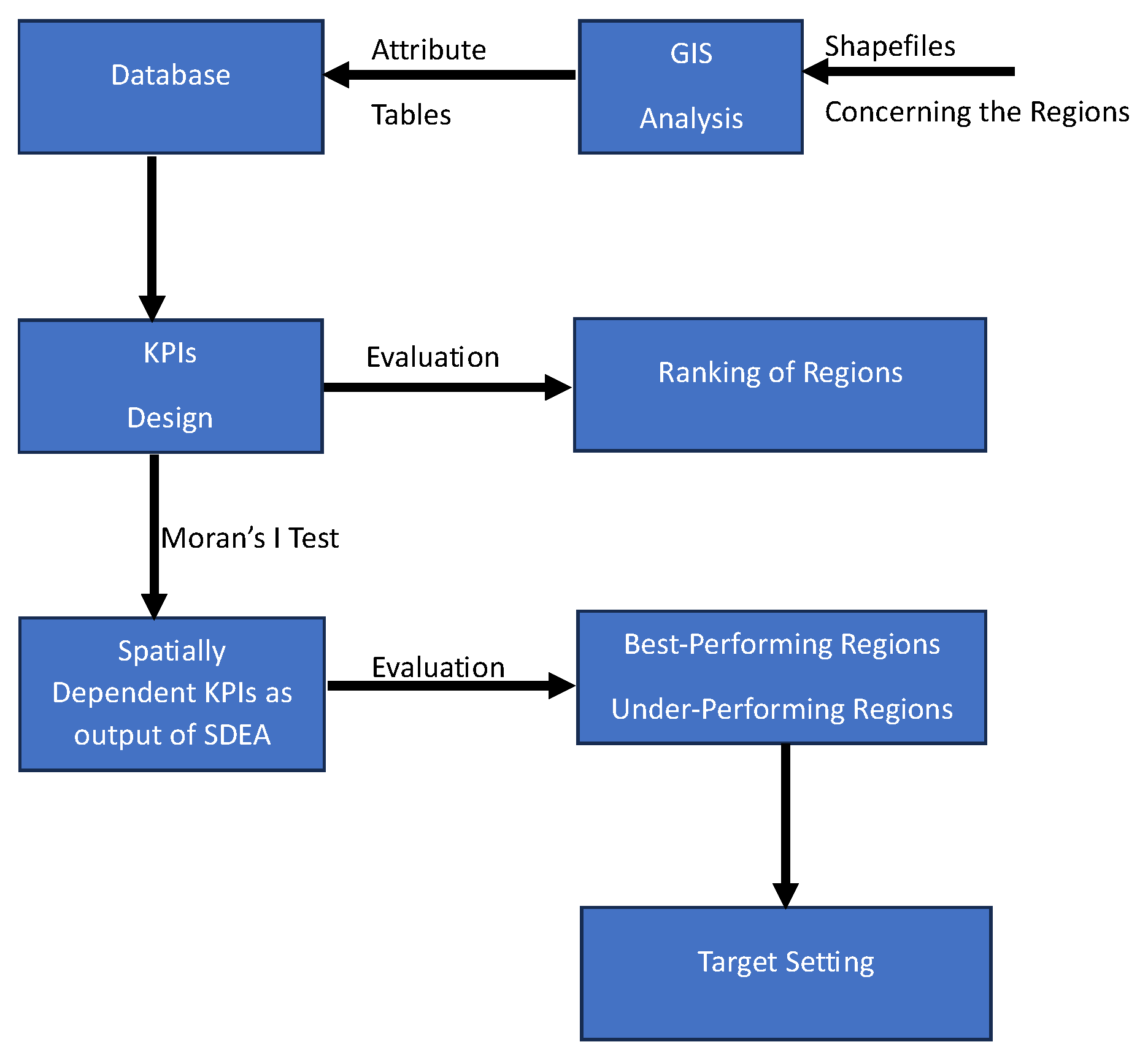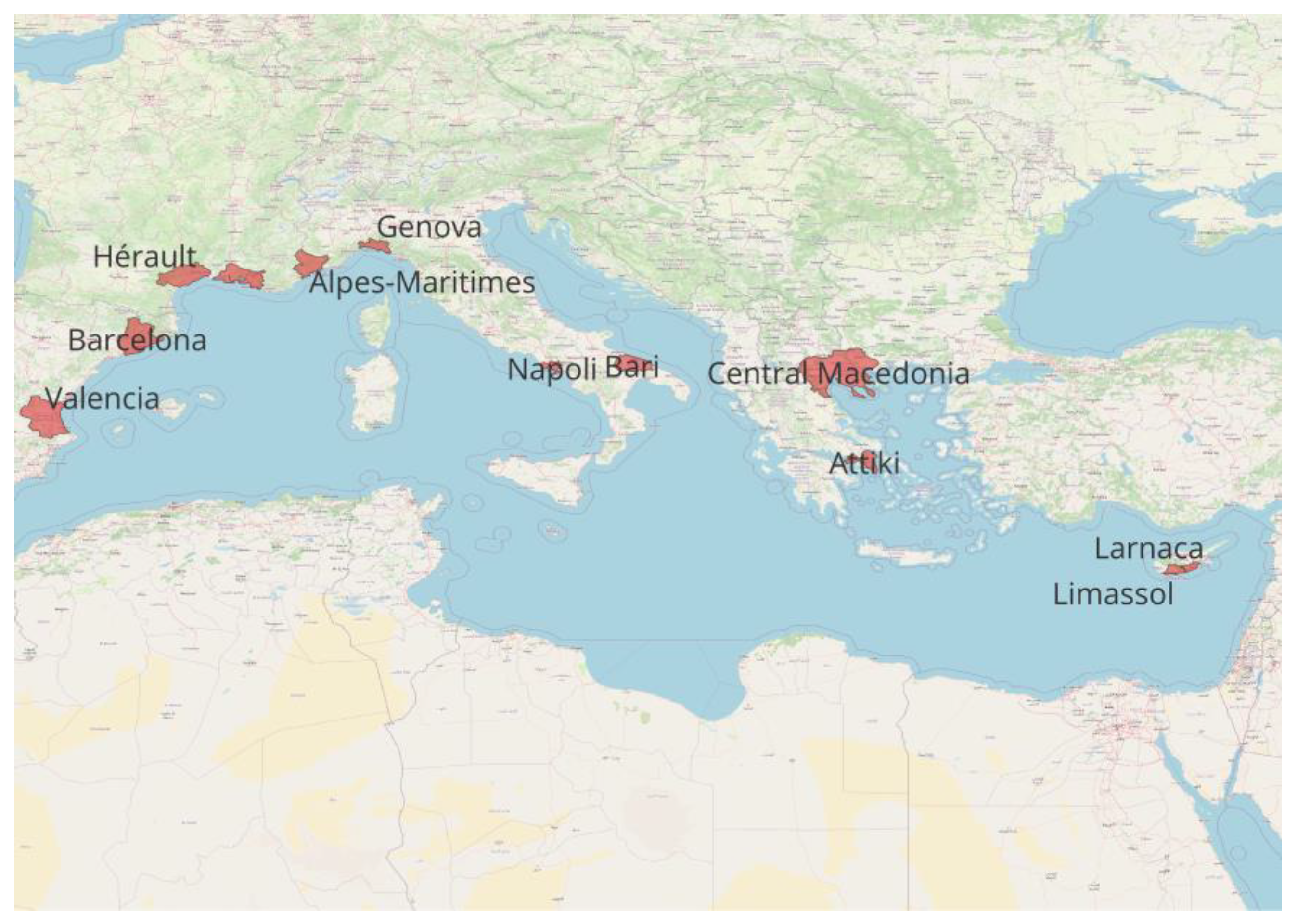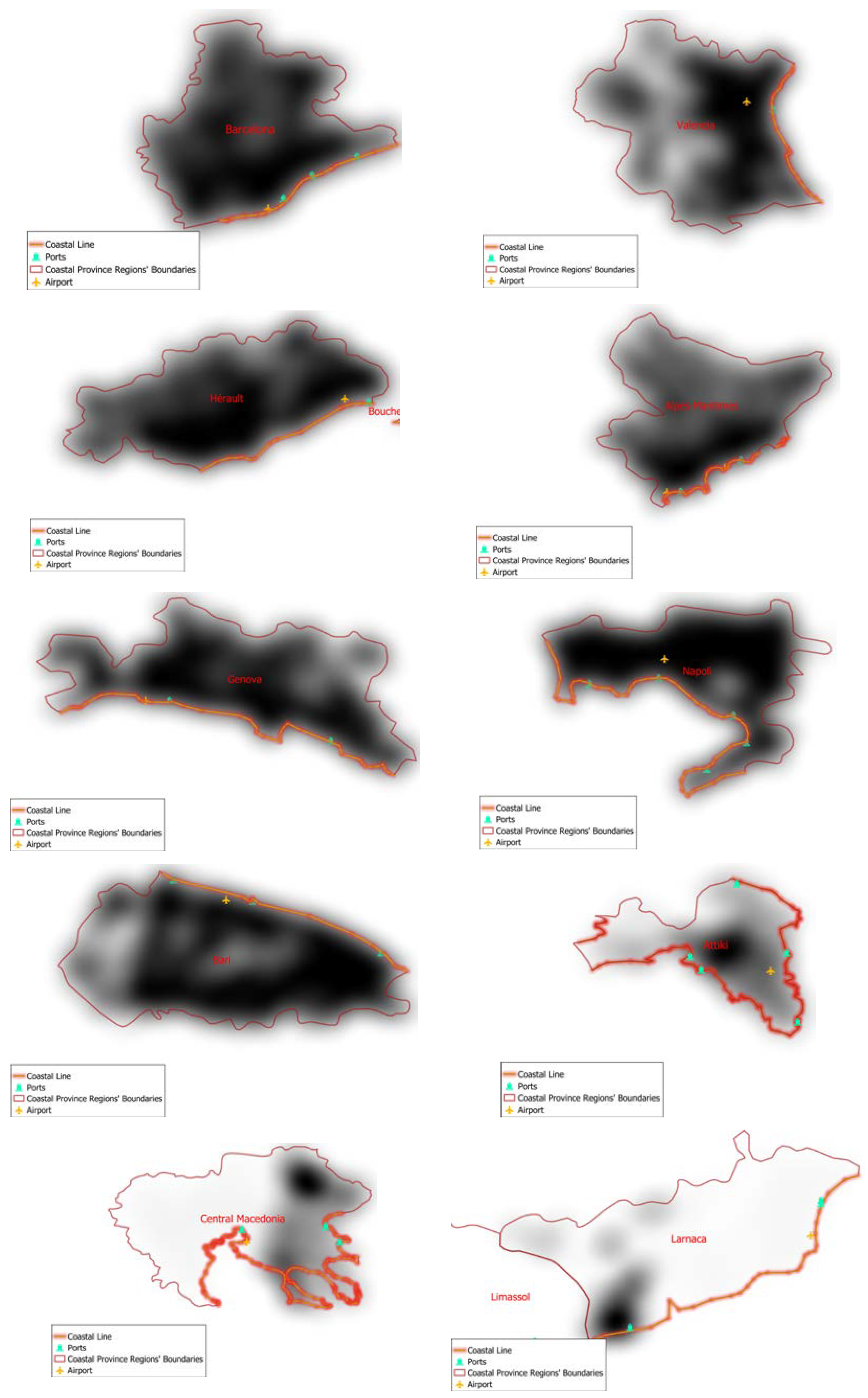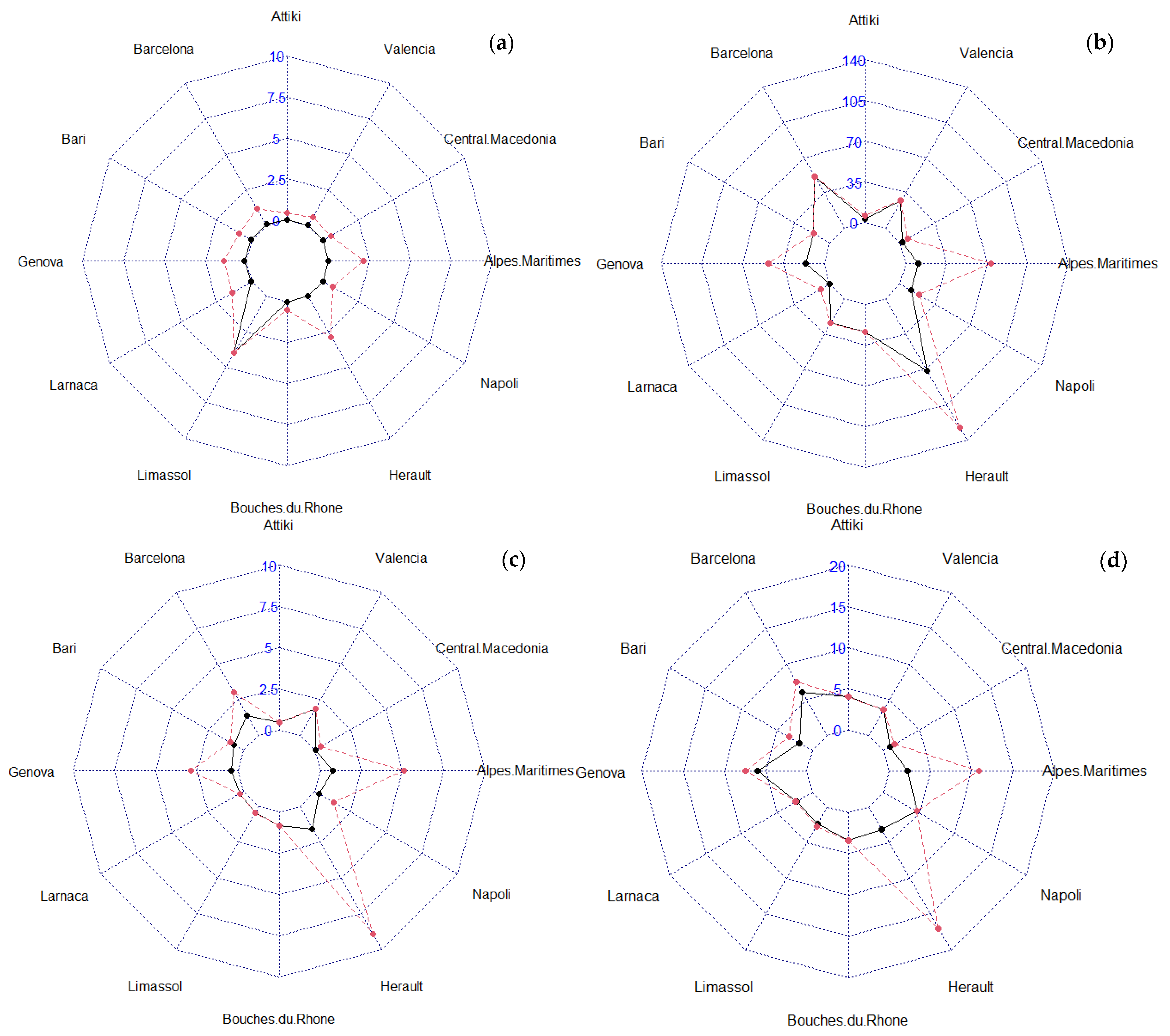Urban Development and Transportation: Investigating Spatial Performance Indicators of 12 European Union Coastal Regions
Abstract
:1. Introduction
2. Methodological Framework
2.1. Morans’ I Test
2.2. Benchmarking Analysis
2.3. Target Setting Approach
3. Study Area and Data Sources
3.1. Research Scope and Study Areas
3.2. Data and Key Performance Indicators
4. Results
4.1. Key Performance Indicators
4.1.1. KPI 1: Buildings’ Capacity
4.1.2. KPI 2: Population Density
4.1.3. KPI 3: Building’s Coverage
4.1.4. KPI 4: Residential Area Coverage
4.1.5. KPI 5: Commercial Area Coverage
4.1.6. KPI 6: Industrial Area Coverage
4.1.7. KPI 7: Public Transport Infrastructure
4.1.8. KPI 8: Cycling Infrastructure
4.1.9. KPI 9: Pedestrian Infrastructure
4.2. Spatial Performance
5. Discussion and Conclusions
Author Contributions
Funding
Data Availability Statement
Conflicts of Interest
References
- Population Growth (Annual %)—European Union World Bank Open Data. Available online: https://data.worldbank.org/indicator/SP.POP.GROW?locations=EU (accessed on 27 April 2023).
- Urban Population—European Union|Data. Available online: https://data.worldbank.org/indicator/SP.URB.TOTL?locations=EU (accessed on 27 April 2023).
- The World Bank. Urban Development. 2017. Available online: https://www.worldbank.org/en/topic/urbandevelopment/overview (accessed on 27 April 2023).
- Aljoufie, M.; Brussel, M.; Zuidgeest, M.; van Maarseveen, M. Urban growth and transport infrastructure interaction in Jeddah between 1980 and 2007. Int. J. Appl. Earth Obs. Geoinf. 2013, 21, 493–505. [Google Scholar] [CrossRef]
- Meyer, M.; Miller, E. Urban Transportation Planning; McGraw Hill: New York, NY, USA, 2001. [Google Scholar]
- Hart, T. Transport and the City. In Handbook of Urban Studies; Paddison, R., Ed.; SAGE Publications Ltd.: London, UK; Thousand Oaks, CA, USA; New Delhi, India, 2001. [Google Scholar]
- Cervero, R. Road expansion, urban growth, and induced travel: A Path Analysis. J. Am. Plan. Assoc. 2003, 69, 145–163. [Google Scholar] [CrossRef]
- Cameron, I.; Lyons, T.; Kenworthy, J. Trends in vehicle kilometres of travel in world cities, 1960–1990: Underlying drivers and policy responses. Transp. Policy 2004, 11, 287–298. [Google Scholar] [CrossRef]
- Millot, M. Urban growth, travel practices and evolution of road safety. J. Transp. Geogr. 2004, 12, 207–218. [Google Scholar] [CrossRef]
- Brueckner, J.K. Urban Sprawl: Diagnosis and Remedies. Int. Reg. Sci. Rev. 2000, 23, 160–171. [Google Scholar] [CrossRef]
- Allen, J.; Lu, K. Modeling and Prediction of Future Urban Growth in the Charleston Region of South Carolina: A GIS-based Integrated Approach. Conserv. Ecol. 2003, 8, 2. [Google Scholar] [CrossRef]
- Perveen, S.; Yigitcanlar, T.; Kamruzzaman; Hayes, J. Evaluating transport externalities of urban growth: A critical review of scenario-based planning methods. Int. J. Environ. Sci. Technol. 2016, 14, 663–678. [Google Scholar] [CrossRef]
- Zhang, L.; Zhang, L.; Liu, X. Evaluation of Urban Spatial Growth Performance from the Perspective of a Polycentric City: A Case Study of Hangzhou. Land 2022, 11, 1173. [Google Scholar] [CrossRef]
- Wang, J.; Zhou, J. Spatial evaluation of the accessibility of public service facilities in Shanghai: A community differentiation perspective. PLoS ONE 2022, 17, e0268862. [Google Scholar] [CrossRef]
- Ji, J.; Wang, D. Regional differences, dynamic evolution, and driving factors of tourism development in Chinese coastal cities. Ocean Coast. Manag. 2022, 226, 106262. [Google Scholar] [CrossRef]
- Doerr, L.; Dorn, F.; Gaebler, S.; Potrafke, N. How new airport infrastructure promotes tourism: Evidence from a synthetic control approach in German regions. Reg. Stud. 2020, 54, 1402–1412. [Google Scholar] [CrossRef]
- Boulos, J. Sustainable Development of Coastal Cities-Proposal of a Modelling Framework to Achieve Sustainable City-Port Connectivity. Procedia—Soc. Behav. Sci. 2016, 216, 974–985. [Google Scholar] [CrossRef]
- Kityuttachai, K.; Tripathi, N.K.; Tipdecho, T.; Shrestha, R. CA-Markov Analysis of Constrained Coastal Urban Growth Modeling: Hua Hin Seaside City, Thailand. Sustainability 2013, 5, 1480–1500. [Google Scholar] [CrossRef]
- Nikolaou, P.; Basbas, S.; Politis, I.; Borg, G. Trip and Personal Characteristics towards the Intention to Cycle in Larnaca, Cyprus: An EFA-SEM Approach. Sustainability 2020, 12, 4250. [Google Scholar] [CrossRef]
- Amprasi, V.; Politis, I.; Nikiforiadis, A.; Basbas, S. Comparing the microsimulated pedestrian level of service with the users’ perception: The case of Thessaloniki, Greece, coastal front. Transp. Res. Procedia 2020, 45, 572–579. [Google Scholar] [CrossRef]
- Tzanni, O.; Nikolaou, P.; Giannakopoulou, S.; Arvanitis, A.; Basbas, S. Social Dimensions of Spatial Justice in the Use of the Public Transport System in Thessaloniki, Greece. Land 2022, 11, 2032. [Google Scholar] [CrossRef]
- Vaz, E.d.N.; Nijkamp, P.; Painho, M.; Caetano, M. A multi-scenario forecast of urban change: A study on urban growth in the Algarve. Landsc. Urban Plan. 2012, 104, 201–211. [Google Scholar] [CrossRef]
- Sdoukopoulos, A.; Pitsiava-Latinopoulou, M.; Basbas, S.; Papaioannou, P. Measuring progress towards transport sustainability through indicators: Analysis and metrics of the main indicator initiatives. Transp. Res. Part D Transp. Environ. 2018, 67, 316–333. [Google Scholar] [CrossRef]
- Aljoufie, M.; Zuidgeest, M.; Brussel, M.; van Maarseveen, M. Spatial–temporal analysis of urban growth and transportation in Jeddah City, Saudi Arabia. Cities 2012, 31, 57–68. [Google Scholar] [CrossRef]
- Boeing, G.; Higgs, C.; Liu, S.; Giles-Corti, B.; Sallis, J.F.; Cerin, E.; Lowe, M.; Adlakha, D.; Hinckson, E.; Moudon, A.V.; et al. Using open data and open-source software to develop spatial indicators of urban design and transport features for achieving healthy and sustainable cities. Lancet Glob. Health 2022, 10, e907–e918. [Google Scholar] [CrossRef]
- Dur, F.; Yigitcanlar, T. Assessing land-use and transport integration via a spatial composite indexing model. Int. J. Environ. Sci. Technol. 2014, 12, 803–816. [Google Scholar] [CrossRef]
- Dur, F.; Yigitcanlar, T.; Bunker, J. A Spatial-Indexing Model for Measuring Neighbourhood-Level Land-Use and Transport Integration. Environ. Plan. B Plan. Des. 2014, 41, 792–812. [Google Scholar] [CrossRef]
- Nikolaou, P.; Dimitriou, L. Lessons to be Learned from Top-50 Global Container Port Terminals Efficiencies: A Multi-Period DEA-Tobit Approach. Marit. Transp. Res. 2021, 2, 100032. [Google Scholar] [CrossRef]
- Olejnik, A.; Żółtaszek, A.; Olejnik, J. Spatial Solution to Measure Regional Efficiency—Introducing Spatial Data Envelopment Analysis. Econ. Reg. 2021, 17, 1166–1180. [Google Scholar] [CrossRef]
- Desai, A.; Storbeck, J.E. A data envelopment analysis for spatial efficiency. Comput. Environ. Urban Syst. 1990, 14, 145–156. [Google Scholar] [CrossRef]
- Anselin, A.L.; Rey, S.J. (Eds.) Perspectives on Spatial Data Analysis. In Perspectives on Spatial Data Analysis; Advances in Spatial Science; Springer: Berlin/Heidelberg, Germany, 2010; ISBN 978-3-642-01976-0. [Google Scholar]
- Bogetoft, P.; Otto, L. Benchmarking with DEA, SFA, and R; Springer: New York, NY, USA, 2011. [Google Scholar]
- Charnes, A.; Cooper, W.W.; Rhodes, E. Measuring the efficiency of decision making units. Eur. J. Oper. Res. 1978, 2, 429–444. [Google Scholar] [CrossRef]
- Sherman, H.D.; Zhu, J. Service Productivity Management: Improving Service Performance Using Data Envelopment Analysis (DEA); Springer Science+Business Media, LLC.: New York, NY, USA, 2006. [Google Scholar]
- Cooper, W.W.; Seiford, L.M.; Tone, K. Data Envelopment Analysis: A Comprehensive Text with Models, Applications, References and DEA-Solver Software, 2nd ed.; Springer Science+Business Media, LLC.: New York, NY, USA, 2007. [Google Scholar]
- GHSL—Global Human Settlement Layer. Global Human Settlement—Download—European Commission. 2016. Available online: https://ghsl.jrc.ec.europa.eu/download.php?ds=pop (accessed on 5 May 2023).
- OpenStreetMap. 2022. Available online: https://www.openstreetmap.org/copyright (accessed on 1 May 2023).
- Navigation (No Date) Transport Networks—GISCO—Eurostat. Available online: https://ec.europa.eu/eurostat/web/gisco/geodata/reference-data/transport-networks (accessed on 5 May 2023).
- Natural Earth—Free Vector and Raster Map Data at 1:10m, 1:50m, and 1:110m Scales. Available online: https://www.naturalearthdata.com (accessed on 5 May 2023).
- Urbanization Effects. Environment. 2021. Available online: https://www.nationalgeographic.com/environment/article/urban-threats (accessed on 1 August 2023).
- Henning-Hager, U. Urban development and road safety. Accid. Anal. Prev. 1986, 18, 135–145. [Google Scholar] [CrossRef]
- Suwarlan, S.A.; Lee, Y.L.; Said, I. A review of agricultural and coastal cities in indonesia in finding urban sprawl priority parameters. Modul 2022, 22, 91–99. [Google Scholar] [CrossRef]
- Wolff, C.; Nikoletopoulos, T.; Hinkel, J.; Vafeidis, A.T. Future urban development exacerbates coastal exposure in the Mediterranean. Sci. Rep. 2020, 10, 14420. [Google Scholar] [CrossRef]
- Aguilar, J.A.P.; Añó, V.A.C.; Sánchez, J. Urban growth dynamics (1956–1998) in mediterranean coastal regions: The case of alicante, spain. In Desertification in the Mediterranean Region. A Security Issue; Springer: Dordrecht, The Netherlands, 2006; pp. 325–340. [Google Scholar]
- Inouye, C.E.N.; de Sousa, W.C.; de Freitas, D.M.; Simões, E. Modelling the spatial dynamics of urban growth and land use changes in the north coast of São Paulo, Brazil. Ocean Coast. Manag. 2015, 108, 147–157. [Google Scholar] [CrossRef]
- Ramajo, J.; Marquez, M.; Hewings, G. Addressing spatial heterogeneity in Regional Technical Efficiency. SSRN Electron. J. 2020. [Google Scholar] [CrossRef]
- Theodora, Y.; Spanogianni, E. Assessing coastal urban sprawl in the Athens’ southern waterfront for reaching sustainability and resilience objectives. Ocean Coast. Manag. 2022, 222, 106090. [Google Scholar] [CrossRef]






| Variable | Description | Measure Unit | Source |
|---|---|---|---|
| Tot_Pop | Total residential population | Total number of people | European Commision [36] |
| Road_length | Length of road infrastructure | Kilometers | OpenStreetMaps [37] |
| Cycleway_length | Length of cycleway | Kilometers | OpenStreetMaps [37] |
| Ped_length | Length pedestrian infrastructure | Kilometers | OpenStreetMaps [37] |
| PT_length | Length of public transportation network | Kilometers | OpenStreetMaps [37] |
| Num_POIs | Points of interest | Number of points (e.g., tourist attractions shopping areas, religious sites) | OpenStreetMaps [37] |
| Num_Build | Buildings | Number of buildings (e.g., hotels, residential, offices) | OpenStreetMaps [37] |
| Build_area | Building area | Square kilometers | OpenStreetMaps [37] |
| Res_build_area | Area of buildings inside residential land | Square kilometers | OpenStreetMaps [37] |
| Park_loc | Locations with parking | Number of parking locations | OpenStreetMaps [37] |
| Airports | Location of airports | Number of airports | Euostat [38] |
| Ports | Location of ports | Number of ports | Euostat [38] |
| Res_area | Residential area | Square kilometers | OpenStreetMaps [37] |
| Com_area | Commercial area | Square kilometers | OpenStreetMaps [38] |
| Ind_area | Industrial area | Square kilometers | OpenStreetMaps [38] |
| PT_infra | Public transport infrastructure | Number of bus stops, railway stations, platforms, tram stops | OpenStreetMaps [38] |
| Region_area | Total area of the region | Square kilometers | Natural Earth [39] |
| Coast_length | Coastal line length | Kilometers | Natural Earth [39] |
| KPI | Value | Measure Unit |
|---|---|---|
| KPI 1: Buildings’ capacity | Tot_Pop/Res_build_area | People per sqr. meters of residential buildings’ area |
| KPI 2: Population density | Tot_Pop/Res_area | People per sqr. meters of residential area |
| KPI 3: Building’ coverage | Res_build_area/Res_area | % of covered residential area from the buidings’ area |
| KPI 4: Residential area coverage | Res_area/Region_area | % of residential area to the total area of the region |
| KPI 5: Commercial area coverage | Com_area/Region_area | % of commercial area to the total area of the region |
| KPI 6: Industrial area coverage | Ind_area/Region_area | % of industrial area to the total area of the region |
| KPI 7: Public transport infrastructure | PT_length/ Road_length | % of public transportation length compared to total road length |
| KPI 8: Cycling infrastructure | Cycleway_length/ Road_length | % of cycleway length compared to total road length |
| KPI 9: Walking infrastructure | Ped_length/ Road_length | % of pedestrian pathway length compared to total road length |
| Region | Country | KPI1 | KPI2 | KPI3 | KPI4 | KPI5 | KPI6 | KPI7 | KPI8 | KPI9 |
|---|---|---|---|---|---|---|---|---|---|---|
| Hérault | France | 0.018 (12) | 0.003 (12) | 16.35 (5) | 6.39 (8) | 0.08 (7) | 0.55 (5) | 71.48 (1) | 1.55 (2) | 3.92 (7) |
| Bouches-du-Rhône | France | 0.029 (11) | 0.004 (9) | 14.32 (6) | 9.09 (9) | 0.16 (10) | 2.41 (11) | 24.01 (6) | 0.84 (4) | 4.29 (6) |
| Alpes-Maritimes | France | 0.032 (10) | 0.003 (11) | 8.16 (9) | 9.41 (10) | 0.69 (12) | 0.49 (4) | 10.85 (8) | 0.78 (5) | 2.83 (9) |
| Larnaca | Cyprus | 0.051 (9) | 0.003 (10) | 5.37 (11) | 5.48 (6) | 0.05 (5) | 0.59 (6) | 0.00 (12) | 0.24 (11) | 2.79 (10) |
| Central Macedonia | Greece | 0.059 (8) | 0.004 (8) | 6.49 (10) | 2.37 (3) | 0.02 (3) | 0.25 (2) | 1.78 (10) | 0.06 (12) | 1.15 (12) |
| Attiki | Greece | 0.061 (7) | 0.010 (6) | 16.77 (4) | 11.82 (12) | 0.10 (8) | 1.54 (9) | 3.30 (9) | 0.43 (7) | 4.99 (4) |
| Valencia | Spain | 0.063 (6) | 0.008 (7) | 12.47 (7) | 2.91 (4) | 0.04 (4) | 0.95 (8) | 27.15 (5) | 1.90 (1) | 4.50 (5) |
| Napoli | Italy | 0.087 (5) | 0.026 (4) | 29.41 (1) | 10.21 (11) | 0.27 (11) | 2.51 (12) | 70.65 (2) | 0.26 (10) | 5.76 (3) |
| Bari | Italy | 0.139 (4) | 0.033 (3) | 23.97 (3) | 0.96 (2) | 0.06 (6) | 0.74 (7) | 38.21 (4) | 0.67 (6) | 2.27 (11) |
| Barcelona | Spain | 0.157 (3) | 0.014 (5) | 8.86 (8) | 5.64 (7) | 0.12 (9) | 2.04 (10) | 51.17 (3) | 1.39 (3) | 7.67 (1) |
| Genova | Italy | 0.287 (2) | 0.072 (2) | 25.12 (2) | 0.56 (1) | 0.01 (1) | 0.21 (1) | 16.03 (7) | 0.40 (9) | 7.49 (2) |
| Limassol | Cyprus | 7.938 (1) | 0.405 (1) | 5.10 (12) | 4.52 (5) | 0.01 (2) | 0.37 (3) | 0.00 (11) | 0.41 (8) | 2.92 (8) |
| KPIs | Moran’s I Test Significance (p-Value) | Z-Score | Interpretation |
|---|---|---|---|
| KPI 1 | 0.05 | 1.63 | Spatial Dependence |
| KPI 2 | 0.08 | 1.42 | Spatial Independence |
| KPI 3 | 0.41 | 0.22 | Spatial Independence |
| KPI 4 | 0.75 | −0.69 | Spatial Independence |
| KPI 5 | 0.61 | −0.28 | Spatial Independence |
| KPI 6 | 0.25 | 0.68 | Spatial Independence |
| KPI 7 | 0.05 | 1.62 | Spatial Dependence |
| KPI 8 | 0.00 | 3.65 | Spatial Dependence |
| KPI 9 | 0.03 | 1.91 | Spatial Dependence |
| Region (Country) | Output: KPI1 Efficiency | Output: KPI7 Efficiency | Output: KPI8 Efficiency | Output: KPI9 Efficiency |
|---|---|---|---|---|
| Attiki (Greece) | 13.97 | 2.31 | 1.00 | 1.00 |
| Barcelona (Spain) | 14.68 | 1.00 | 2.18 | 1.23 |
| Bari (Italy) | 12.54 | 1.19 | 1.42 | 1.82 |
| Genova (Italy) | 9.53 | 1.00 | 7.05 | 1.25 |
| Larnaca (Cyprus) | 54.24 | 12142.76 | 1.09 | 1.03 |
| Limassol (Cyprus) | 1.00 | 1.00 | 1.00 | 1.15 |
| Bouches-du-Rhône (France) | 33.84 | 1.00 | 1.00 | 1.00 |
| Hérault (France) | 319.55 | 2.33 | 5.76 | 5.42 |
| Napoli (Italy) | 15.73 | 1.85 | 4.97 | 1.00 |
| Alpes-Maritimes (France) | 136.32 | 1.00 | 6.56 | 4.83 |
| Central Macedonia (Greece) | 18.64 | 5.06 | 7.51 | 1.66 |
| Valencia (Spain) | 18.90 | 1.00 | 1.00 | 1.00 |
Disclaimer/Publisher’s Note: The statements, opinions and data contained in all publications are solely those of the individual author(s) and contributor(s) and not of MDPI and/or the editor(s). MDPI and/or the editor(s) disclaim responsibility for any injury to people or property resulting from any ideas, methods, instructions or products referred to in the content. |
© 2023 by the authors. Licensee MDPI, Basel, Switzerland. This article is an open access article distributed under the terms and conditions of the Creative Commons Attribution (CC BY) license (https://creativecommons.org/licenses/by/4.0/).
Share and Cite
Nikolaou, P.; Basbas, S. Urban Development and Transportation: Investigating Spatial Performance Indicators of 12 European Union Coastal Regions. Land 2023, 12, 1757. https://doi.org/10.3390/land12091757
Nikolaou P, Basbas S. Urban Development and Transportation: Investigating Spatial Performance Indicators of 12 European Union Coastal Regions. Land. 2023; 12(9):1757. https://doi.org/10.3390/land12091757
Chicago/Turabian StyleNikolaou, Paraskevas, and Socrates Basbas. 2023. "Urban Development and Transportation: Investigating Spatial Performance Indicators of 12 European Union Coastal Regions" Land 12, no. 9: 1757. https://doi.org/10.3390/land12091757







